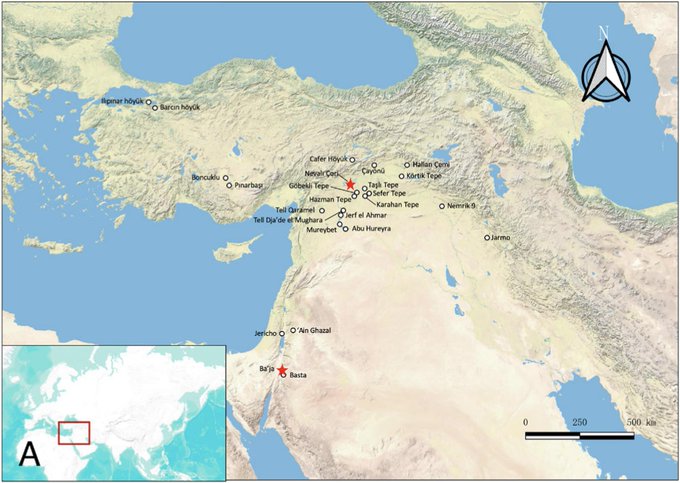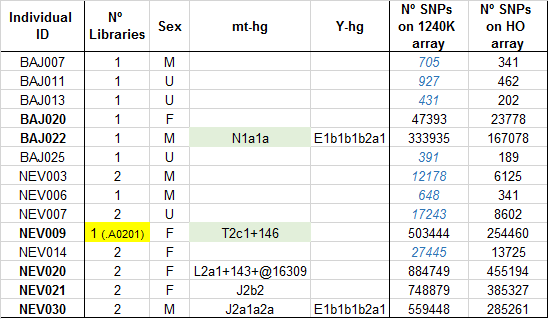kingjohn
Regular Member
- Messages
- 2,232
- Reaction score
- 1,202
- Points
- 113
Significance
We present the integrative bioarchaeological study on the Pre-Pottery Neolithic B (PPNB) in the Southeastern Anatolia by combining isotopic data (87Sr/86Sr, δ18O, and δ13Ccarb), new radiocarbon dates, and genome-wide data recovered from human skeletal remains from the site of Nevalı Çori. We also report human genome-wide data from post-Neolithic Nevalı Çori and the late PPNB site of Ba'ja in the Southern Levant. Our combined isotope and ancient DNA data fill a research gap between prehistoric Anatolian and Levantine populations. Our results indicate a decline in human mobility after the first phase of the PPNB in the Southeastern Anatolia accompanied by increasing reliance on domesticated resources and evidence of consanguinity in the PPNB Levant.
Abstract
Growing reliance on animal and plant domestication in the Near East and beyond during the Pre-Pottery Neolithic B (PPNB) (the ninth to eighth millennium BC) has often been associated with a “revolutionary” social transformation from mobility toward more sedentary lifestyles. We are able to yield nuanced insights into the process of the Neolithization in the Near East based on a bioarchaeological approach integrating isotopic and archaeogenetic analyses on the bone remains recovered from Nevalı Çori, a site occupied from the early PPNB in Turkey where some of the earliest evidence of animal and plant domestication emerged, and from Ba'ja, a typical late PPNB site in Jordan. In addition, we present the archaeological sequence of Nevalı Çori together with newly generated radiocarbon dates. Our results are based on strontium (87Sr/86Sr), carbon, and oxygen (δ18O and δ13Ccarb) isotopic analyses conducted on 28 human and 29 animal individuals from the site of Nevalı Çori. 87Sr/86Sr results indicate mobility and connection with the contemporaneous surrounding sites during the earlier PPNB prior to an apparent decline in this mobility at a time of growing reliance on domesticates. Genome-wide data from six human individuals from Nevalı Çori and Ba'ja demonstrate a diverse gene pool at Nevalı Çori that supports connectedness within the Fertile Crescent during the earlier phases of Neolithization and evidence of consanguineous union in the PPNB Ba'ja and the Iron Age Nevalı Çori.
source:
https://www.pnas.org/doi/10.1073/pnas.2210611120


p.s
the ppnb individual from ba'ja site jordan BAJ022 dated to 7250-6800 bc was e-m34
and the iron age individual from nevali cori site NEV030 dated to 769-483 bc was e-m84 ( ftdna family discover tool defined it even farther as e-m84>e-y5435>e-fgc18401)
We present the integrative bioarchaeological study on the Pre-Pottery Neolithic B (PPNB) in the Southeastern Anatolia by combining isotopic data (87Sr/86Sr, δ18O, and δ13Ccarb), new radiocarbon dates, and genome-wide data recovered from human skeletal remains from the site of Nevalı Çori. We also report human genome-wide data from post-Neolithic Nevalı Çori and the late PPNB site of Ba'ja in the Southern Levant. Our combined isotope and ancient DNA data fill a research gap between prehistoric Anatolian and Levantine populations. Our results indicate a decline in human mobility after the first phase of the PPNB in the Southeastern Anatolia accompanied by increasing reliance on domesticated resources and evidence of consanguinity in the PPNB Levant.
Abstract
Growing reliance on animal and plant domestication in the Near East and beyond during the Pre-Pottery Neolithic B (PPNB) (the ninth to eighth millennium BC) has often been associated with a “revolutionary” social transformation from mobility toward more sedentary lifestyles. We are able to yield nuanced insights into the process of the Neolithization in the Near East based on a bioarchaeological approach integrating isotopic and archaeogenetic analyses on the bone remains recovered from Nevalı Çori, a site occupied from the early PPNB in Turkey where some of the earliest evidence of animal and plant domestication emerged, and from Ba'ja, a typical late PPNB site in Jordan. In addition, we present the archaeological sequence of Nevalı Çori together with newly generated radiocarbon dates. Our results are based on strontium (87Sr/86Sr), carbon, and oxygen (δ18O and δ13Ccarb) isotopic analyses conducted on 28 human and 29 animal individuals from the site of Nevalı Çori. 87Sr/86Sr results indicate mobility and connection with the contemporaneous surrounding sites during the earlier PPNB prior to an apparent decline in this mobility at a time of growing reliance on domesticates. Genome-wide data from six human individuals from Nevalı Çori and Ba'ja demonstrate a diverse gene pool at Nevalı Çori that supports connectedness within the Fertile Crescent during the earlier phases of Neolithization and evidence of consanguineous union in the PPNB Ba'ja and the Iron Age Nevalı Çori.
source:
https://www.pnas.org/doi/10.1073/pnas.2210611120


p.s
the ppnb individual from ba'ja site jordan BAJ022 dated to 7250-6800 bc was e-m34
and the iron age individual from nevali cori site NEV030 dated to 769-483 bc was e-m84 ( ftdna family discover tool defined it even farther as e-m84>e-y5435>e-fgc18401)


